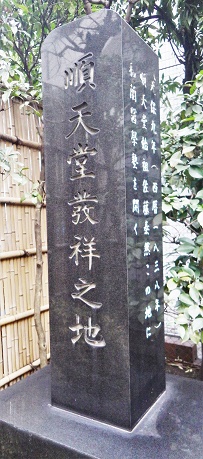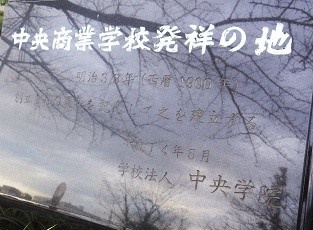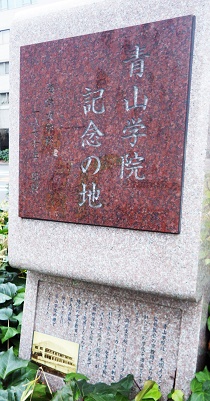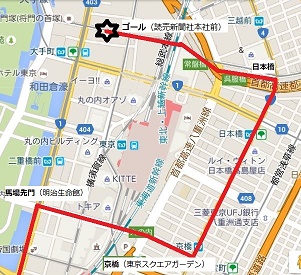More than a week ![]() before
before ![]() the 92nd Hakone Ekiden Main Event of New Year's Day. There is a sign saying "Notice of Traffic Regulation" on Kajibashi Street, which tells you that this will be the Hakone Ekiden course on January 3 of the New Year.
the 92nd Hakone Ekiden Main Event of New Year's Day. There is a sign saying "Notice of Traffic Regulation" on Kajibashi Street, which tells you that this will be the Hakone Ekiden course on January 3 of the New Year.  On the outbound route, start in front of the Yomiuri Shimbun headquarters in Otemachi, go straight south on Hibiya Street in Chiyoda-ku, but the last 10th ward on January 3 runs in Chuo-ku. In this way, Hakone Ekiden is a big event of the New Year, but in addition to running in Chuo-ku in the last ward, this race, in fact, has a deep connection with Chuo-ku.
On the outbound route, start in front of the Yomiuri Shimbun headquarters in Otemachi, go straight south on Hibiya Street in Chiyoda-ku, but the last 10th ward on January 3 runs in Chuo-ku. In this way, Hakone Ekiden is a big event of the New Year, but in addition to running in Chuo-ku in the last ward, this race, in fact, has a deep connection with Chuo-ku.
Currently, the start / goal point is Otemachi, where the Yomiuri Shimbun headquarters is located, but from the postwar period until 1971, the headquarters of the Yomiuri Shimbun was in Ginza (currently the place ![]()
![]() where Plantan Ginza is located), Ginza in Chuo-ku was exactly the start / goal of Hakone Ekiden.
where Plantan Ginza is located), Ginza in Chuo-ku was exactly the start / goal of Hakone Ekiden.
Unfortunately, among the 21 teams participating this year, there is no university in Chuo-ku, but three of them are universities closely related to Chuo-ku in history.
One is Juntendo University. This university currently has campuses in Hongo and Sakura (Chiba Prefecture), but in 1838 (Tenpo 9), Taizen Sato founded Wada Juku in Yagenbori (currently Higashinihombashi) where he studied Dutch medicine. It is the origin.
[The Monument of the birthplace of Juntendo in Yagenbori]
The second school is Chuo Gakuin. This is currently headquartered in Abiko City (Chiba Prefecture), but its origin is Nihonbashi Simple Commercial Night School, which was established in Shinkawa in 1900. After that, Nihonbashi Simple Commercial Night School became a Central Commercial School and Chuo Commerce Junior College, and junior colleges were abolished in 2000, but it is Chuo Gakuin University that participated this time.
[Monument of the birthplace of Chuo Commercial School (Chuo Gakuin) in Shinkawa Park]
The third school is Aoyama Gakuin, who won last year. The current headquarters is also located in Shibuya, but its origins are Kogaku Gakusha, which was established in 1878 by Julius Sober in Tsukiji Akashicho. Kokyo Gakusha later merged with Azabu Women's Elementary School (later relocated to Akashicho to become a coastal girls' school) and Mikai Shin School in Yokohama Yamate, and became Aoyama Gakuin after going through Tokyo English School and Tokyo Eiwa School.  [Aoyama Gakuin Memorial Land in Akashicho] Monument
[Aoyama Gakuin Memorial Land in Akashicho] Monument
The anchor runners![]() who climbed Hibiya-dori, the 10th ward of the return trip on January 3, turn right at Baba Sanmon
who climbed Hibiya-dori, the 10th ward of the return trip on January 3, turn right at Baba Sanmon ![]() (Marunouchi, Chiyoda-ku) and enter Kajibashi-dori. After crossing
(Marunouchi, Chiyoda-ku) and enter Kajibashi-dori. After crossing ![]() the Shinkansen guard and Sotobori-dori St. and entering Chuo-ku, turn left in
the Shinkansen guard and Sotobori-dori St. and entering Chuo-ku, turn left in ![]() front of Tokyo Square Garden, enter Chuo-dori, cross Nihonbashi and
front of Tokyo Square Garden, enter Chuo-dori, cross Nihonbashi and![]() run through the ward at once to Tokiwa Bridge. Actually, this course was a different course until 17 years ago. In 1999, the course was changed to Kyobashi and Nihonbashi to commemorate the 88th anniversary of the Nihonbashi Bridge and the 75th Hakone Ekiden Convention. Along this line is the Meiji Seimeikan (Marunouchi, Chiyoda-ku), Mitsubishi Ichigokan Museum, Tokyo (Marunouchi), Dai-ichi Seimei Mutual Hall (Kyobashi), Meijiya (Kyobashi), Takashimaya (Nihonbashi), Mitsukoshi (Nihonbashi Muromachi), and the Bank of Japan (Honishimachi) are expected to have many traditional and beautiful buildings. It's a good course to enjoy the cityscape with support!
run through the ward at once to Tokiwa Bridge. Actually, this course was a different course until 17 years ago. In 1999, the course was changed to Kyobashi and Nihonbashi to commemorate the 88th anniversary of the Nihonbashi Bridge and the 75th Hakone Ekiden Convention. Along this line is the Meiji Seimeikan (Marunouchi, Chiyoda-ku), Mitsubishi Ichigokan Museum, Tokyo (Marunouchi), Dai-ichi Seimei Mutual Hall (Kyobashi), Meijiya (Kyobashi), Takashimaya (Nihonbashi), Mitsukoshi (Nihonbashi Muromachi), and the Bank of Japan (Honishimachi) are expected to have many traditional and beautiful buildings. It's a good course to enjoy the cityscape with support!
Last year's Hakone Ekiden has been reported in detail by correspondent Tataro Edo with photos (/archive/2015/01/post-2270.html).
Monument of the birthplace of Juntendo
Location 2-6-8, Higashi Nihonbashi, Chuo-ku, 103-0004, Japan (Yagenbori Fudoin precinct)
[Monument of the birthplace of the Central Commercial School]
Location 1-32, Shinkawa, Chuo-ku, 104-0033, Japan (in Shinkawa Park)
[Monument of Aoyama Gakuin Memorial Land]
Location 6-26 Akashicho, Chuo-ku, 104-0044, Japan (in front of Nichirei Akashicho Building)

